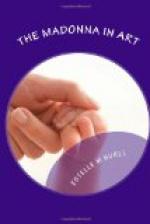The seventeenth century produced many pictures of this class; among them, a beautiful work by Guido Reni, in Rome, deserves mention, being executed with greater care than was usual with him. Sassoferrato and Carlo Dolce frequently painted the subject. Their Madonnas often seem affected, not to say sentimental, after the simpler and nobler types of the earlier period. But nowhere is their peculiar sweetness more appropriate than beside a sleeping babe. The Corsini picture by Carlo Dolce is an exquisite nursery scene. Its popularity depends more, perhaps, upon the babe than the mother. Like Lady Isobel’s child in another poem of motherhood by Mrs. Browning, he sleeps—
“Fast, warm, as if its
mother’s smile,
Laden with love’s dewy
weight,
And red as rose of Harpocrate,
Dropt upon its eyelids, pressed
Lashes to cheek in a sealed
rest.”
In Northern Madonna art, the Mater Amabilis is the preeminent subject. This fact is due partly to the German theological tendency to subordinate the mother to her divine Son, but more especially to the characteristic domesticity of Teutonic peoples. From Van Eyck and Schongauer, through Duerer and Holbein, down to Rembrandt and Rubens, we trace this strongly marked predilection in every style of composition, regardless of proprieties. Van Eyck does not hesitate to occupy his richly dressed enthroned Madonna at Frankfort with giving her breast to her babe, and Duerer portrays the same maternal duties in the Virgin on the Crescent Moon. Holbein’s Meyer Madonna, splendid with her jewelled crown, is not less motherly than Schongauer’s young Virgin sitting in a rude stable.
Rembrandt in humble Dutch interiors, Rubens in numerous Holy Families modelled upon the Flemish life about him always conceive of the Virgin Mother as delighting in her maternal cares. As has been said of Duerer’s Madonna,—and the description applies equally well to many others in the North,—“She suckles her son with a calm feeling of happiness; she gazes upon him with admiration as he lies upon her lap; she caresses him and presses him to her bosom without a thought whether it is becoming to her, or whether she is being admired.”
[Illustration: DUeRER.—MADONNA AND CHILD.]
This entire absence of posing on the part of the German Virgin is one of the most admirable elements in this art. This characteristic is perfectly illustrated in Duerer’s portrait Madonna of the Belvedere Gallery, at Vienna. This is an excellent specimen of the master, who, alone of the Germans, is considered the peer of his great Italian contemporaries. Frankly admired both by Titian and Raphael, he has in common with them the supreme gift of seeing and reproducing natural human affections. His work, however, is as thoroughly German as theirs is Italian. The Madonna of this picture has the round, maidenly face of the typical German ideal. A transparent veil droops over the flowing hair, covered by a blue drapery above. The mother holds her child high in her arms, bending her face over him. The babe is a beautiful little fellow, full of vivacity. He holds up a pear gleefully, to meet his mother’s smile. The picture is painted with great delicacy of finish.




